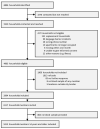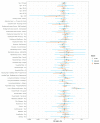Prevalence and Risk Factors of Infection in the Representative COVID-19 Cohort Munich
- PMID: 33808249
- PMCID: PMC8038115
- DOI: 10.3390/ijerph18073572
Prevalence and Risk Factors of Infection in the Representative COVID-19 Cohort Munich
Abstract
Given the large number of mild or asymptomatic SARS-CoV-2 cases, only population-based studies can provide reliable estimates of the magnitude of the pandemic. We therefore aimed to assess the sero-prevalence of SARS-CoV-2 in the Munich general population after the first wave of the pandemic. For this purpose, we drew a representative sample of 2994 private households and invited household members 14 years and older to complete questionnaires and to provide blood samples. SARS-CoV-2 seropositivity was defined as Roche N pan-Ig ≥ 0.4218. We adjusted the prevalence for the sampling design, sensitivity, and specificity. We investigated risk factors for SARS-CoV-2 seropositivity and geospatial transmission patterns by generalized linear mixed models and permutation tests. Seropositivity for SARS-CoV-2-specific antibodies was 1.82% (95% confidence interval (CI) 1.28-2.37%) as compared to 0.46% PCR-positive cases officially registered in Munich. Loss of the sense of smell or taste was associated with seropositivity (odds ratio (OR) 47.4; 95% CI 7.2-307.0) and infections clustered within households. By this first population-based study on SARS-CoV-2 prevalence in a large German municipality not affected by a superspreading event, we could show that at least one in four cases in private households was reported and known to the health authorities. These results will help authorities to estimate the true burden of disease in the population and to take evidence-based decisions on public health measures.
Keywords: COVID-19; SARS-CoV-2; infection fatality ratio; population-based cohort study; seroprevalence; underreporting.
Conflict of interest statement
F.F., T.F., D.M., L.O. and V.T. report grants from the Bavarian State Ministry of Science and the Arts during the conduct of the study. T.F. reports grants from the University Hospital of LMU Munich, Helmholtz Center Munich, University of Bonn, University of Bielefeld, and German Ministry for Education and Research during the conduct of the study. J.H. reports grants from the German Federal Ministry of Education and Research during the conduct of the study. M.H. and A.W. report personal fees and non-financial support, L.O. and M.P. report non-financial support from Roche Diagnostics. M.H., L.O., M.P. and A.W. report non-financial support from Euroimmun, Viramed, and Mikrogen. M.H., M.P. and A.W. report grants, non-financial support, and other from German Center for Infection Research (DZIF). F.F., M.H., L.O., M.P., V.T. and A.W. report grants and non-financial support from the Government of Bavaria. M.H., L.O., M.P., and A.W. report non-financial support from BMW, Mercedes Benz, Munich Police, and Accenture. M.H. and A.W. report personal fees and non-financial support from Box Betrobox during the conduct of the study. L.O. and M.P. report non-financial support from Box Betrobox. M.H. and A.W. have a patent Sample System for Sputum Diagnostics of SARS-CoV-2 pending. D.M. reports to be a sub-investigator on a phase I SARS-CoV-2 vaccine trial and on a phase I rabies vaccine trial, both sponsored by CureVac AG. M.P. and A.W. report non-financial support from Becker MVZ. V.T. reports support from CureVac AG outside the submitted work. A.W. reports personal fees and other from Haeraeus Sensors. A.W. reports non-financial support from Bruker Daltronics outside the submitted work. A.W. is involved in other different patents and companies not in relation with the serology of SARS-CoV-2. All other authors report nothing to disclose.
Figures






References
-
- Coronavirus in München: Die Aktuelle Entwicklung [Internet] [(accessed on 9 October 2020)];2020 Available online: https://www.muenchen.de/aktuell/2020-03/coronavirus-muenchen-infektion-a....
-
- Bundesministerium für Gesundheit: Coronavirus SARS-CoV-2: Chronik der Bisherigen Maßnahmen [Internet] [(accessed on 17 March 2021)];2021 Available online: https://www.bundesgesundheitsministerium.de/coronavirus/chronik-coronavi....
Publication types
MeSH terms
Grants and funding
LinkOut - more resources
Full Text Sources
Other Literature Sources
Medical
Miscellaneous

